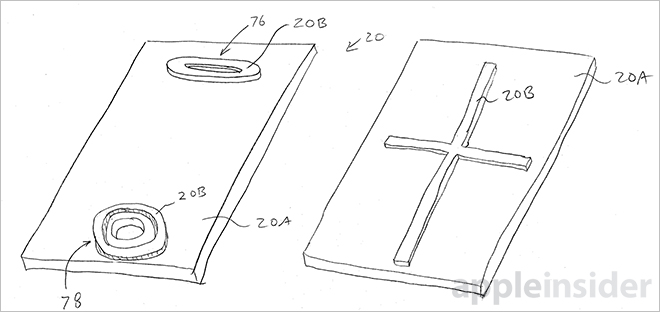Apple on Monday was granted a U.S. patent covering a method of fusing glass structures together to encapsulate the internal circuitry of an iOS device, and that of larger electronics like monitors and televisions.

Source: USPTO
The U.S. Patent and Trademark Office awarded Apple U.S. Patent No. 8,773,848 for "Fused glass device housings," which describes a procedure that allows for the efficient fabrication of seamless all-glass electronic device casings.
As noted by Apple, all-glass structures can be heavy, especially if the material is layered to protect against scratches, drops and other accidental damage. The company proposes a new construction method that ensures durability, a lightweight design and eye-pleasing aesthetics.
Instead of using a completely glass-on-glass build, Apple suggests joining glass pieces together via a fusing process. According to the patent, the edges of planar and peripheral glass members can be fused together to form a sufficiently thick piece of material that may be machined down to a desired shape. For example, the illustration below shows a media player with rounded edges and flexible display.

To bolster the casing's structural integrity, raised glass features can be fused to the planar member at weak points in the build. Examples include the addition of glass structures around holes or openings in the glass member, as well as internal support ribs placed that reduce flexing and breakage. Cutouts in the glass surface can serve as holes for buttons and other physical device controls.

In some embodiments, glass members are fused together to create a five-sided box in which displays, circuitry and other internal components can be inserted, or "slid into place." This is especially crucial for larger applications like televisions or monitors that are mounted on stands.
The back portion -- side opposite that of the display -- can be tinted a translucent color or made opaque to hide unsightly batteries, chips and flex cables, though Apple leaves an option to keep all sides transparent. Portions of planar glass members may be "roughened" to help scatter and diffuse light around display edges.
Once the internals are inserted, an end cap is placed over the opening to seal off the structure from debris and other contaminants.
Illustration of device with stand.
Finally, the patent goes into detail on polishing and glass strengthening techniques, as well as alternative embodiments that involve extruded hollow glass rods with fused end caps. Additional attention is paid to glass fusing methods that reduce frit to leave seamless joints.
With Apple's latest iOS device designs, it appears the company is moving further away from the "glass sandwich" aesthetic introduced with the iPhone 4. Combined with rumors of sapphire crystal adoption over Gorilla Glass, the patented glass fusing technology may never make its way to the consumer market. Then again, Apple does hold patents for sapphire lamination and fusion technology that could work well with today's granted IP.
Apple's seamless fused glass housing patent was first filed for in 2013 and credits Peter Russell-Clarke, Michael K. Pilliod and SVP of Design Jony Ive as its inventors.